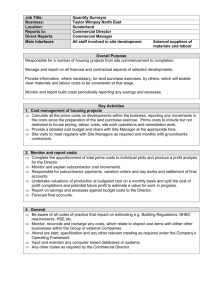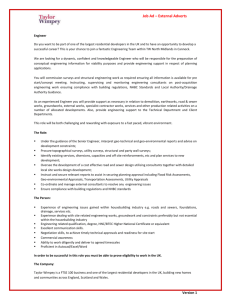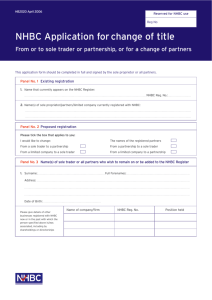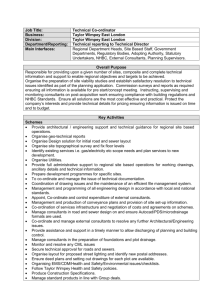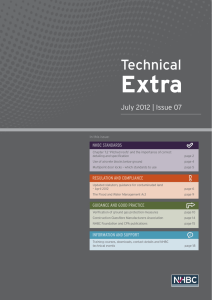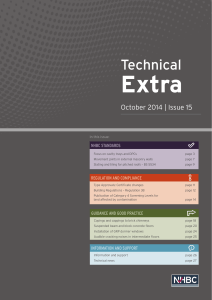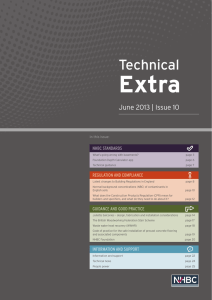Air leakage testing
advertisement
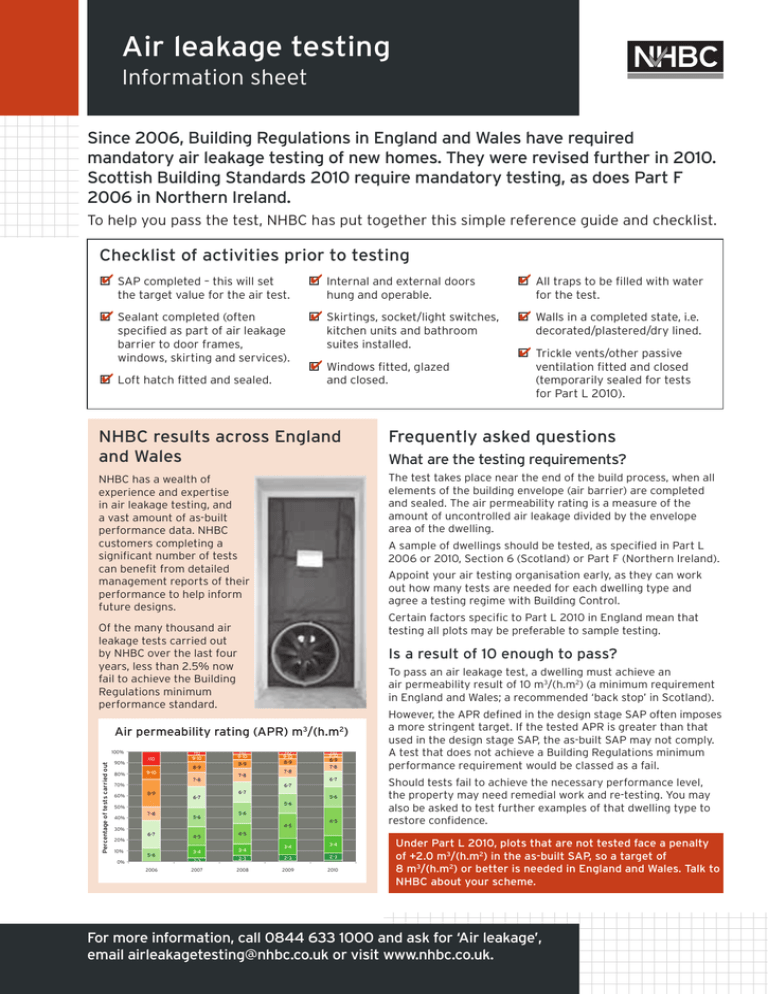
Air leakage testing Information sheet Since 2006, Building Regulations in England and Wales have required mandatory air leakage testing of new homes. They were revised further in 2010. Scottish Building Standards 2010 require mandatory testing, as does Part F 2006 in Northern Ireland. To help you pass the test, NHBC has put together this simple reference guide and checklist. Checklist of activities prior to testing ✔ SAP completed – this will set o ✔ Internal and external doors o the target value for the air test. ✔ Sealant completed (often o hung and operable. ✔ Skirtings, socket/light switches, o specified as part of air leakage barrier to door frames, windows, skirting and services). ✔ Loft hatch fitted and sealed. o kitchen units and bathroom suites installed. ✔ Windows fitted, glazed o and closed. ✔ All traps to be filled with water o for the test. ✔ Walls in a completed state, i.e. o decorated/plastered/dry lined. ✔ Trickle vents/other passive o ventilation fitted and closed (temporarily sealed for tests for Part L 2010). NHBC results across England and Wales Frequently asked questions NHBC has a wealth of experience and expertise in air leakage testing, and a vast amount of as-built performance data. NHBC customers completing a significant number of tests can benefit from detailed management reports of their performance to help inform future designs. The test takes place near the end of the build process, when all elements of the building envelope (air barrier) are completed and sealed. The air permeability rating is a measure of the amount of uncontrolled air leakage divided by the envelope area of the dwelling. A sample of dwellings should be tested, as specified in Part L 2006 or 2010, Section 6 (Scotland) or Part F (Northern Ireland). Appoint your air testing organisation early, as they can work out how many tests are needed for each dwelling type and agree a testing regime with Building Control. Certain factors specific to Part L 2010 in England mean that testing all plots may be preferable to sample testing. Of the many thousand air leakage tests carried out by NHBC over the last four years, less than 2.5% now fail to achieve the Building Regulations minimum performance standard. Is a result of 10 enough to pass? To pass an air leakage test, a dwelling must achieve an air permeability result of 10 m3/(h.m2) (a minimum requirement in England and Wales; a recommended ‘back stop’ in Scotland). Air permeability rating (APR) m3/(h.m2) Percentage of tests carried out 100% 90% 80% >10 >10 9-10 8-9 9-10 7-8 >10 9-10 8-9 7-8 70% 60% 6-7 >10 9-10 8-9 7-8 6-7 5-6 5-6 7-8 5-6 5-6 4-5 30% 6-7 20% 10% 7-8 6-7 50% 40% >10 9-10 8-9 6-7 8-9 5-6 0% 2006 4-5 What are the testing requirements? 4-5 However, the APR defined in the design stage SAP often imposes a more stringent target. If the tested APR is greater than that used in the design stage SAP, the as-built SAP may not comply. A test that does not achieve a Building Regulations minimum performance requirement would be classed as a fail. Should tests fail to achieve the necessary performance level, the property may need remedial work and re-testing. You may also be asked to test further examples of that dwelling type to restore confidence. 4-5 3-4 3-4 3-4 3-4 2-3 2-3 2-3 2-3 2007 2008 2009 2010 Under Part L 2010, plots that are not tested face a penalty of +2.0 m3/(h.m2) in the as-built SAP, so a target of 8 m3/(h.m2) or better is needed in England and Wales. Talk to NHBC about your scheme. For more information, call 0844 633 1000 and ask for ‘Air leakage’, email airleakagetesting@nhbc.co.uk or visit www.nhbc.co.uk. Top tips Common problem areas that need attention n Keep construction details simple and easy to follow. n Service penetrations, especially in bathrooms and kitchens (e.g. hidden behind bath panel or boxed services, behind kitchen units or extract covers). n Ensure site staff know the importance of the air barrier and where it is. n Seal blockwork. Apply parge coat/ plaster to external walls before studwork for partitions. Plan carefully as it may affect sequencing of work. n Dry lining – use a ribbon of adhesive/ sealant around each perimeter and around penetrations such as light switches and sockets. n For timber frame, a separate vapour control layer (e.g. 500g polythene) is likely to be the air barrier. Ensure the membrane is lapped and sealed with tape or sealant – ensure tears and punctures are repaired. n Partition junctions, particularly with external walls or ceiling. n Suspended floors, especially around perimeters. n Window and door surrounds. n Loft hatch. n Ceiling rose and downlights, especially just below a cold roof area. n Gaps in the air barrier within the roof area, especially around built-in storage rooms. n Ensure services behind kitchen units and bathroom suites are appropriately sealed. n Consider proprietary products, such as: –joist end caps to intermediate floors – top hats or collars to services – suitable covers to recessed lighting. n Ensure an airtight seal between loft hatch and frame. Ensure extra attention to the areas indicated to improve air test results Where can I find further information? ✔ Visit www.nhbc.co.uk/alt or contact NHBC for practical advice, toolbox talks and more in-depth training. ✔ NHBC Foundation report NF16: A practical guide to building airtight dwellings – www.nhbcfoundation.org ✔ Visit NHBC’s TechZone for Building Regulations & Standards and other useful guidance www.nhbc.co.uk/techzone To book your air leakage test, please call NHBC on 0844 633 1000 and ask for ‘Air leakage’. NHBC provides air leakage testing nationwide. UKAS accredited laboratory no. 2688. Member of ATTMA. Associate member of BINDT. For further information, call 0844 633 1000 and ask for ‘Air leakage’, email airleakagetesting@nhbc.co.uk or visit www.nhbc.co.uk. NHBC, NHBC House, Davy Avenue, Knowlhill, Milton Keynes, Bucks MK5 8FP. HB2563 08/11
